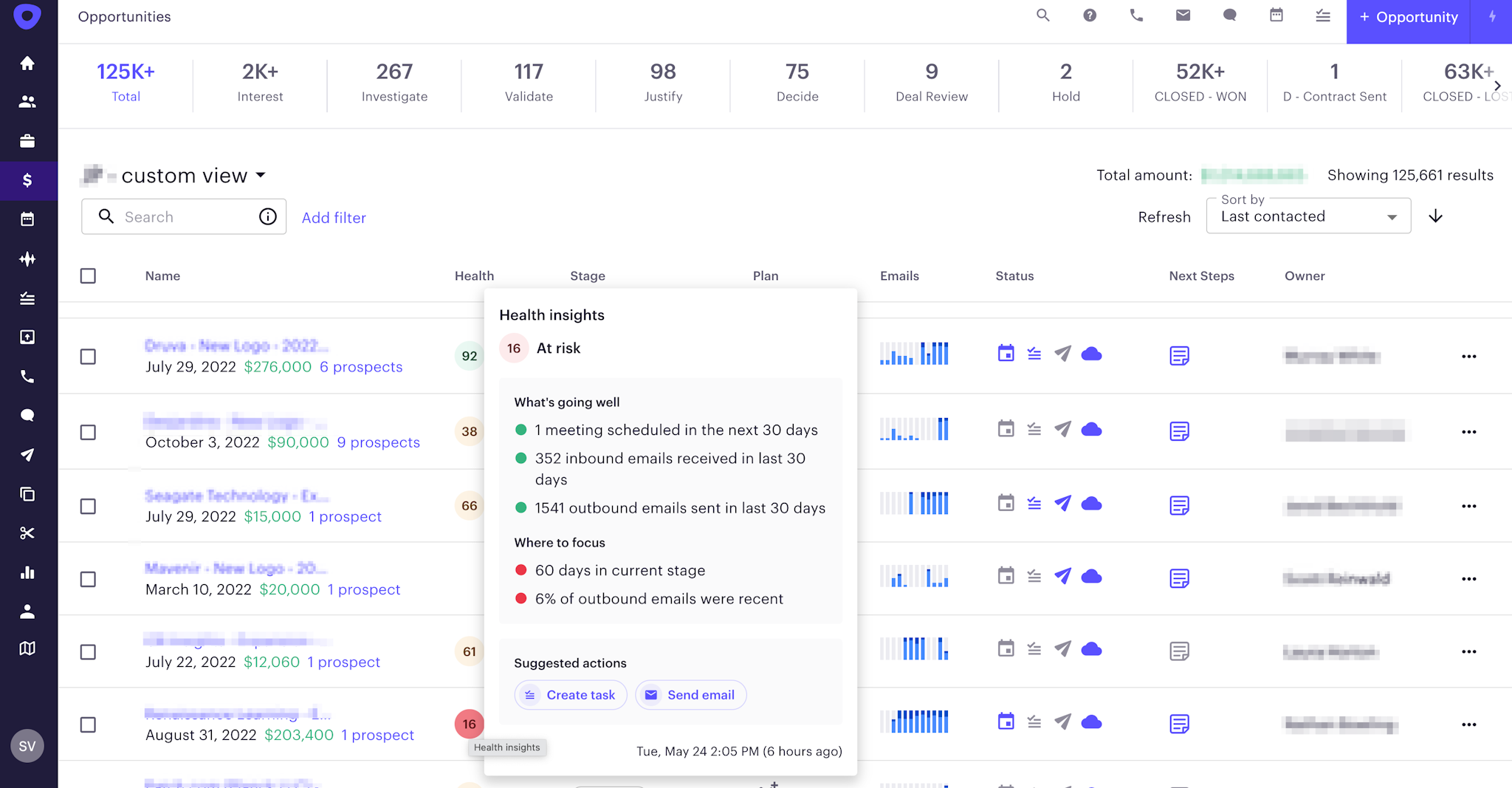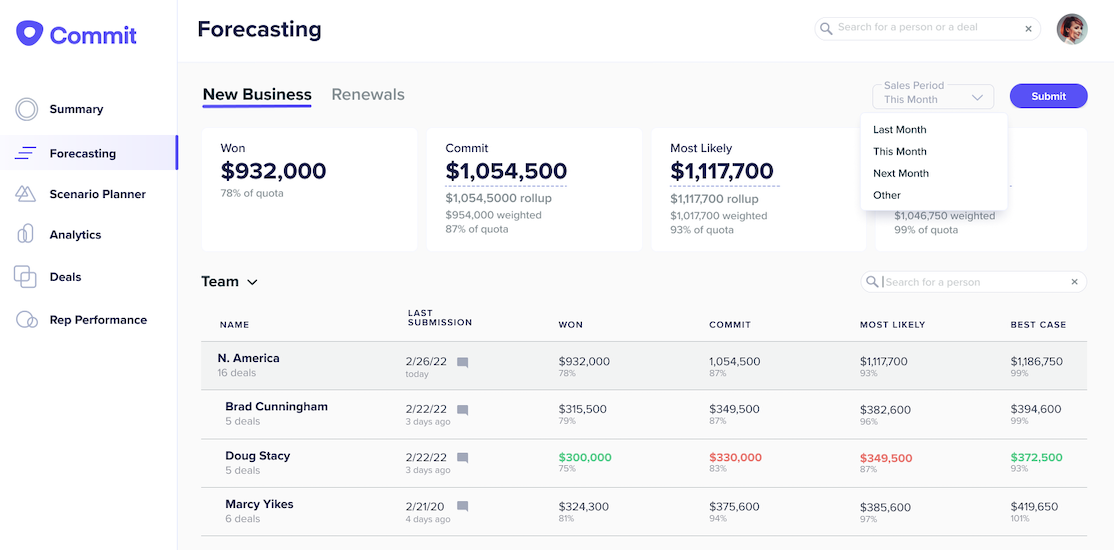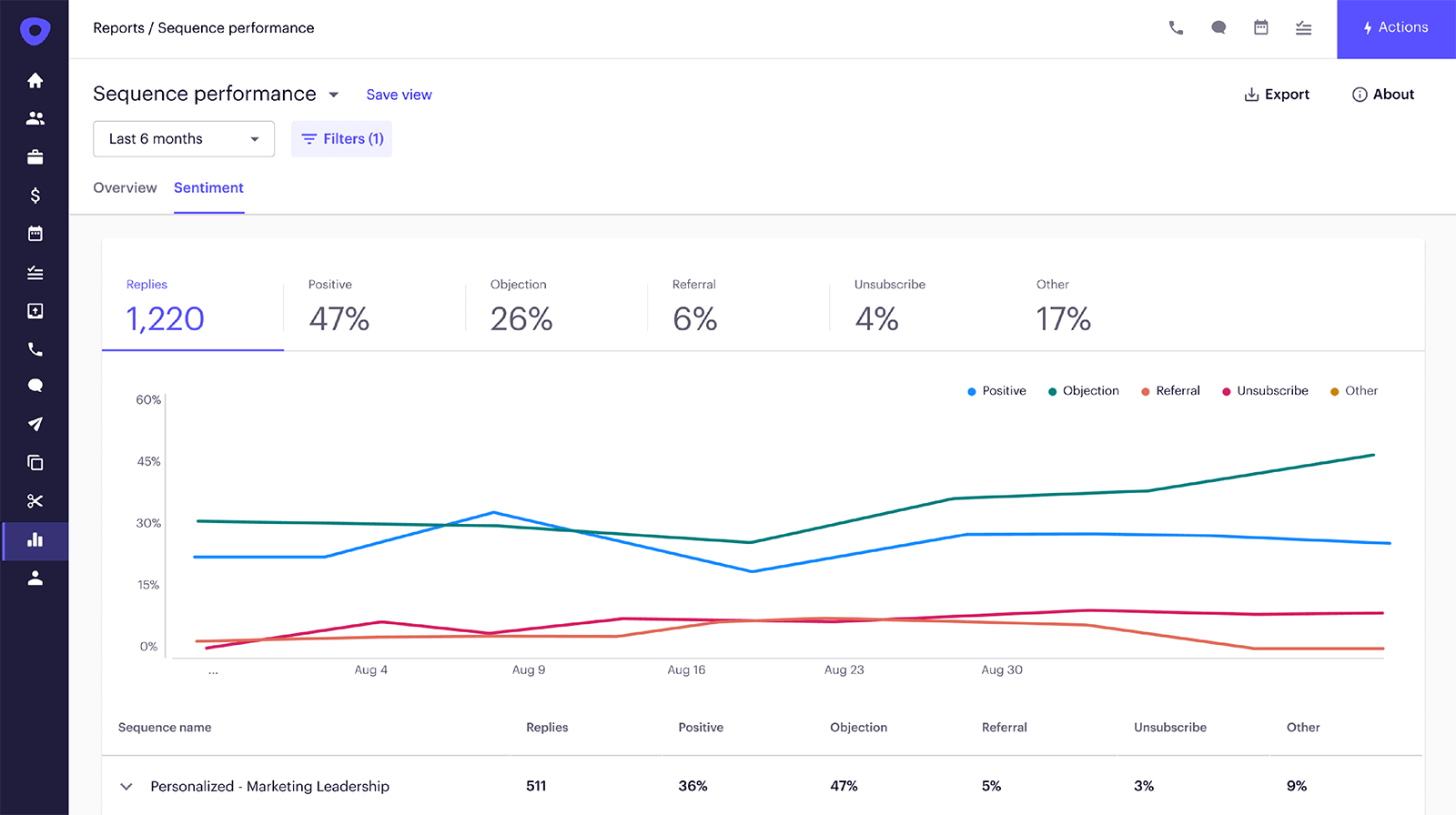A recent Value Selling Associates study found that only 23% of sales reps had enough pipeline to meet their quotas. It’s not surprising then that many sales managers and leaders spend hours every week inspecting their teams’ forecast to uncover what’s at risk, or worse, not real.
As a manager, you’ve probably asked yourself:
- What are my sales teams doing wrong?
- What’s still on track?
- How can I proactively diagnose deal risks?
Without full visibility into your pipeline, it’s difficult to see all the data indicating deal health. So, you might depend on anecdotal attributes of the deal from your reps, which are often based on emotion:
“The deal is going well. We just had a great meeting.”
“The prospect’s email sounded positive.”
“I’m seeing buying signs.”
“My champion is going to help us get this done.”
But if you’re relying on your team to interpret gut feelings, you’re not getting a complete story. While emotion can be an indicator, the future oftentimes turns out differently than how we feel it in the moment…and what about the deals we haven’t gotten a “feel” for yet? Only data reliably indicates deals that could be in jeopardy.
With an increase in distributed teams, there’s no way managers can know every deal inside and out to forecast accurately (let alone which reps need help where), and trying to do that leads to teams feeling micromanaged instead of supported.
What if you had the pipeline visibility to keep deals on track? And what if you could use data to diagnose risks and guide your team to higher close rates?
Let’s take a look at how to:
- Monitor the right buying signals to take the right action to move the right deals forward
- Unlock improvements to sales execution
- Build proven sales playbooks that quickly up-level reps for predictable revenue results
Monitor the right buying signals to take the right action to move the right deals forward
Completing a successful sale means getting many steps right. Skipped or forgotten steps at any stage of the deal reduce your likelihood of closing.
Just do some quick math. Eight reps with 17 deals each in a six-stage sales cycle with two exit criteria per stage results in 544 specific deal attributes to manage. That’s simply not feasible.
Deals generally fall into one of three categories:
- Deals that will close
- Deals that, if you put more time in, will close
- Deals that, no matter how much time you spend, won't close
At Outreach, we use the Outreach Sales Execution Platform to enable our sales reps, managers, and leaders with insights that guide them to take the best next actions on the deals where attention will help the most to unlock revenue.
Instead of basing our actions on emotion, we manage deals by capturing and assessing signals across the full decision-making committee throughout the entire buying cycle. These signals inform the right workflows so our sellers and managers can rely on data – not instinct – to manage and drive their entire pipeline.
For insights, we look at deal signals like:
- How many people are involved in the deal?
- What’s trending for inbound and outbound communication that shows engagement?
- Is the next meeting set? When?
- Are there any open tasks or people in sequence?
- How recent was the last activity?
- Are multiple personas engaged?
- Are we engaged above the decision-making power line?
- How many days has the deal been in its current stage compared to the team average?
- How many times has the close date been moved or has the deal value changed?
Proactive risk assessment is about taking the subjectivity out of forecasting. It’s impossible for managers to assess these signals (and many others) for every rep in every deal, and incomplete assessment forces forecasting to be subjective. The solution is AI-based signal monitoring at scale that leads to objective ranking of deals by risk and a more accurate forecast.
Unlock improvements to sales execution
Every organization has a Sales Execution Gap — the gap between the potential revenue of an organization and the actual revenue it achieves. The Sales Execution Gap has three root causes:
To clear the hurdle, you must define commit criteria for your teams. You want to take the squishiness out of your forecast categories — make them objective.
Traditionally, forecast categories are applied based on a likelihood of winning a deal, e.g. Best Case means the deal has a 60% or greater chance of being won, whereas Upside means we have a less than 60% chance. The subjectivity around how to measure the likelihood of winning a deal creates massive data inconsistency. At Outreach, we use four categories:
- Commit – there is no risk on the deal closing at the value or in the period the customer has agreed to.
- Best Case – there is risk on the deal but we know we have a qualified deal and the customer shared with us when they are making a decision.
- Pipeline – we have a deal; our prospect has a verified problem that we know we can solve. We don’t know when it’s going to close and aren’t ready to formally assess risk.
- Omitted – we don’t know if there’s a deal yet; we haven’t had a meeting or gathered enough information.
With “Best Case” as the category, we further break it into subcategories:
- Green risk – a small risk we can get over to win the deal, so the deal is forecasted.
- Yellow risk – there’s enough risk on the deal we don’t feel like we can overcome it to win the deal by the decision date the customer has shared with us, so the deal is not forecasted.
- Red risk – there’s so much risk that we could lose it, so the deal is not forecasted.
Taking the subjectivity out of forecasting makes it easier to stay proactive and keep deals moving forward. By using our revenue operations solution Outreach Commit and our revenue intelligence solution Outreach Guide, we can determine which deals are worth spending more time on — and which ones aren’t.
For example, a seller has a $300,000 sales gap -- their forecast is $1.7 million, but their quota is $2 million. The deals in the rep’s pipeline not forecasted in the $1.7 million that we might be able to win, but require some extra time and effort, is what we call ‘gap coverage.’
Outreach Guide and Outreach Commit enable reps to quickly understand gap coverage deals and more efficiently manage and close them by diagnosing risks in real-time. A deal health score aggregates all the deal signals so a rep and manager can quickly prioritize and work on the deals with the risk most easily mitigated to meet quota, rather than looking at a list of deals and guessing which ones you can pull into the forecast.

Then, our managers use Outreach Commit to assemble the team forecast by including the deals that we believe will close based on the available signals we are getting from across Outreach. When our team gets together for our weekly forecast call, Outreach Commit gives us a consistent view for every team and we know each forecast is supported by a robust set of health indicators.

It’s no longer a guessing game based on emotions; every action is data-driven. These recommendations can optimize everything from rep execution to selling processes, enabling everyone on the team to sell like a top rep by staying on top of risks that typically go unmitigated merely because they weren’t known.
And as a leader, consistent and clear visibility into deal health and your forecast means you can spend less time preparing the forecast and more time leading your team.
Build proven sales playbooks that quickly up-level reps for predictable revenue results
Many sales teams grapple with the challenges of rep turnover, scattered and undefined sales training, and ad-hoc individual ways of doing things. This results in a slow onboarding process, inconsistent performance, and ultimately, unpredictable execution across the sales cycle — leading to missed forecasts and underachieved growth goals.
Are you hearing things in passing conversation, like:
“I’m responsible for the results but I don’t know what messaging, plays, programs, and investments actually drive the growth of the business.”
And:
“What exactly are our A players doing differently than everyone else?”
Or, even:
“It takes too long to onboard and become productive.”
At Outreach, our reps ramp fast and consistently execute best-practice workflows using our sales engagement solution Outreach Engage. Following proven playbooks, Outreach helps our leaders to coach at scale and our reps to:
- Easily adopt and use our platform to perform the right activities repeatedly
- Implement playbooks and best practices with scalable workflows
- Apply ML/AI built to optimize everything from rep execution to selling processes

Lean into science to drive growth and predictable revenue results
There’s a better option than relying on gut feelings.
By streamlining and instrumenting the end-to-end sales process, Outreach connects your sales activities with outcomes to identify the most effective workflows — and stay ahead of risks. This way, your reps can close more deals by taking the right action. Every. Single. Time.
Request a demo to learn how Outreach can drive growth and increase efficiency across your entire sales organization.